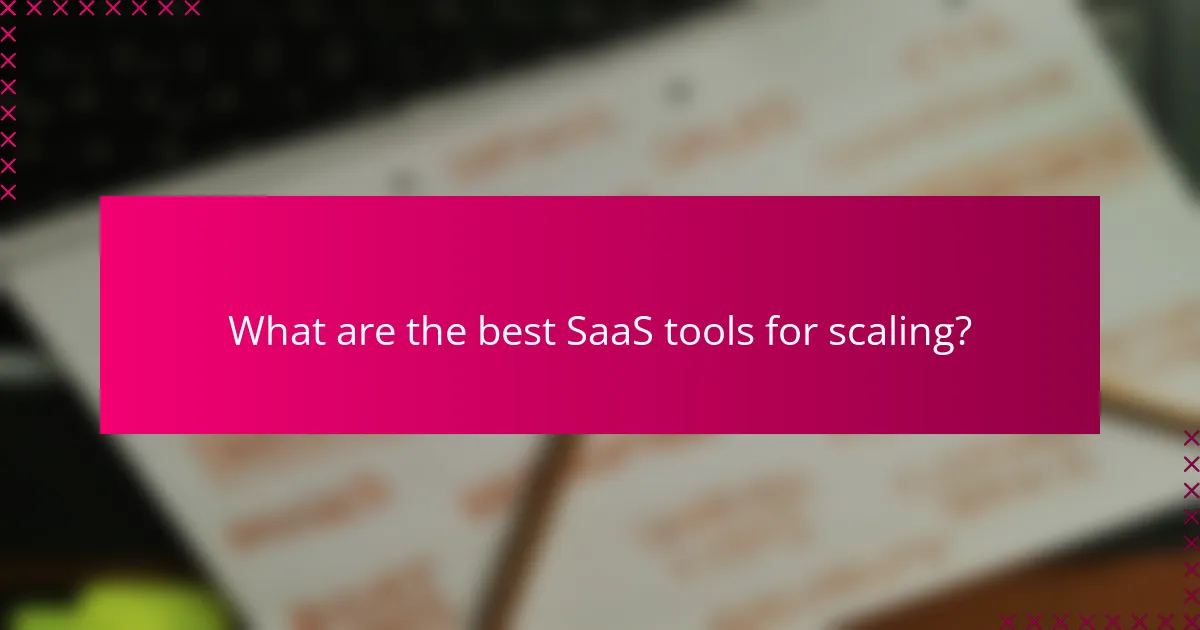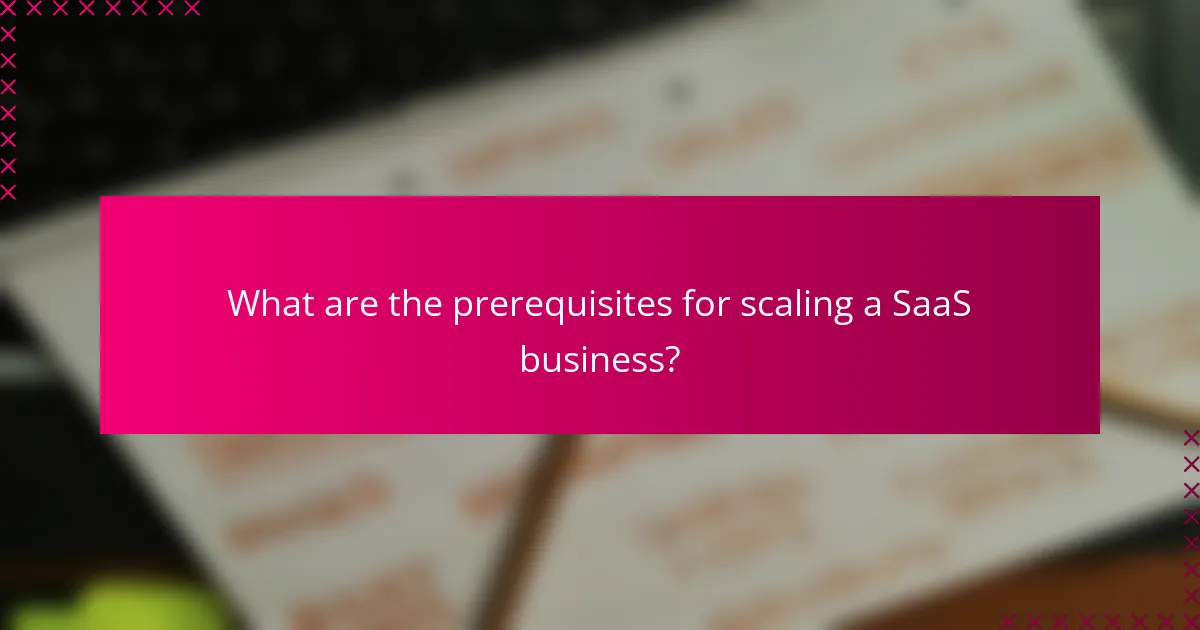SaaS solutions are increasingly vital for businesses looking to scale effectively in a dynamic market. By optimizing resources and enhancing customer experience, companies can adapt to evolving demands while fostering strategic partnerships. Continuous analysis of market trends and the implementation of robust tools for customer relationship management and project management further empower SaaS businesses to maintain competitiveness and drive sustainable growth.

What are effective scaling strategies for SaaS in the UK?
Effective scaling strategies for SaaS in the UK focus on optimizing resources, enhancing customer experience, and fostering partnerships. These strategies help companies grow sustainably while adapting to market demands and technological advancements.
Utilizing cloud infrastructure
Cloud infrastructure is essential for scaling SaaS applications efficiently. It allows businesses to adjust resources based on demand, ensuring that performance remains consistent during peak usage times. Providers like AWS, Azure, and Google Cloud offer flexible pricing models that can accommodate varying budgets.
When selecting a cloud provider, consider factors such as data security, compliance with UK regulations like GDPR, and the ability to integrate with existing systems. A multi-cloud approach can also enhance resilience and reduce vendor lock-in.
Implementing automated workflows
Automated workflows streamline operations, reduce manual errors, and improve efficiency. By automating repetitive tasks, SaaS companies can allocate resources to more strategic initiatives, ultimately enhancing customer satisfaction. Tools like Zapier or Integromat can facilitate these automations without extensive coding knowledge.
Focus on automating areas such as customer onboarding, billing processes, and support ticket management. Regularly review and optimize these workflows to ensure they remain effective as the company scales.
Leveraging customer feedback
Customer feedback is invaluable for scaling SaaS products effectively. Actively seeking input through surveys, interviews, and usage analytics helps identify areas for improvement and new feature opportunities. This feedback loop fosters a customer-centric approach that can drive retention and growth.
Implement tools like NPS (Net Promoter Score) or CSAT (Customer Satisfaction Score) to gauge customer sentiment. Use this data to prioritize development efforts and address pain points promptly, ensuring that your product evolves with user needs.
Expanding through partnerships
Strategic partnerships can accelerate growth by providing access to new markets, resources, and expertise. Collaborating with complementary businesses allows SaaS companies to offer bundled services, enhancing value for customers. Consider partnerships with industry leaders or niche players that align with your target audience.
When forming partnerships, establish clear goals and mutual benefits to ensure a successful collaboration. Regular communication and performance tracking are essential to maintain alignment and adapt strategies as necessary.
Adopting agile methodologies
Agile methodologies enable SaaS companies to respond quickly to market changes and customer needs. By breaking projects into smaller, manageable tasks, teams can iterate rapidly and deliver updates more frequently. This approach fosters innovation and keeps the product aligned with user expectations.
Implement frameworks like Scrum or Kanban to enhance team collaboration and transparency. Regular retrospectives can help identify areas for improvement, ensuring that the scaling process remains efficient and effective.

How can SaaS companies adapt to market changes?
SaaS companies can adapt to market changes by continuously analyzing market trends, adjusting pricing strategies, and enhancing customer support. These strategies enable businesses to remain competitive and responsive to customer needs.
Conducting market analysis
Regular market analysis helps SaaS companies identify emerging trends, customer preferences, and competitive threats. By utilizing tools like surveys, focus groups, and analytics, companies can gather valuable insights that inform their product development and marketing strategies.
Consider segmenting your market analysis by customer demographics or industry verticals to tailor your offerings effectively. This targeted approach can reveal specific needs and opportunities that a broader analysis might overlook.
Implementing flexible pricing models
Flexible pricing models allow SaaS companies to adapt to varying customer budgets and market conditions. Options like tiered pricing, pay-as-you-go, or freemium models can attract a wider range of customers and encourage trial usage.
When implementing these models, consider the trade-offs between customer acquisition and revenue stability. Offering discounts for annual subscriptions can enhance cash flow while also locking in customers for a longer term.
Enhancing customer support
Improving customer support is crucial for SaaS companies to retain users and foster loyalty. Providing multiple support channels, such as live chat, email, and phone assistance, ensures customers can easily access help when needed.
Additionally, investing in self-service resources like knowledge bases and tutorials can empower customers to solve issues independently. Regularly soliciting feedback on support services can help identify areas for improvement and enhance overall customer satisfaction.

What are the best SaaS tools for scaling?
The best SaaS tools for scaling include platforms that enhance customer relationship management, marketing automation, and project management. These tools streamline operations, improve efficiency, and support growth by integrating various business functions.
Salesforce for CRM
Salesforce is a leading customer relationship management (CRM) tool that helps businesses manage customer interactions and data effectively. It offers a comprehensive suite of features, including sales tracking, customer service management, and analytics, which are essential for scaling operations.
When using Salesforce, consider customizing the platform to fit your specific business needs. This may involve integrating third-party applications or utilizing Salesforce’s AppExchange for additional functionalities. A common pitfall is underutilizing its automation features, which can significantly enhance productivity.
HubSpot for marketing automation
HubSpot is a robust marketing automation platform designed to help businesses attract, engage, and delight customers. It offers tools for email marketing, social media management, and content creation, making it easier to execute marketing strategies at scale.
To maximize HubSpot’s potential, focus on segmenting your audience for targeted campaigns and utilizing its analytics to measure performance. Avoid overwhelming your team with too many features at once; instead, start with core functionalities and expand as your team becomes more comfortable with the platform.
Airtable for project management
Airtable is a flexible project management tool that combines the simplicity of a spreadsheet with the power of a database. It allows teams to organize tasks, track progress, and collaborate in real-time, making it ideal for scaling projects efficiently.
When implementing Airtable, take advantage of its templates to quickly set up workflows tailored to your projects. Regularly review and adjust your workflows to ensure they remain effective as your team grows. A common mistake is not training team members adequately, which can lead to underutilization of the platform’s capabilities.

What metrics should SaaS companies track for growth?
SaaS companies should focus on key metrics that directly impact their growth trajectory, including monthly recurring revenue (MRR), customer acquisition cost (CAC), and churn rate. Monitoring these metrics helps businesses understand their financial health, customer behavior, and overall market adaptability.
Monthly recurring revenue (MRR)
Monthly recurring revenue (MRR) is a crucial metric that reflects the predictable income generated from subscriptions each month. It allows SaaS companies to forecast revenue and assess growth trends over time.
To calculate MRR, sum the total subscription revenue from all active customers. For example, if you have 100 customers paying $50 per month, your MRR would be $5,000. Tracking MRR helps identify fluctuations and informs pricing strategies.
Customer acquisition cost (CAC)
Customer acquisition cost (CAC) measures the total expense incurred to acquire a new customer, including marketing and sales costs. Understanding CAC is vital for evaluating the efficiency of your marketing strategies and ensuring sustainable growth.
To calculate CAC, divide total sales and marketing expenses by the number of new customers acquired in a specific period. For instance, if you spent $10,000 to acquire 100 customers, your CAC would be $100. Keeping CAC low while maintaining quality leads is essential for profitability.
Churn rate
Churn rate indicates the percentage of customers who cancel their subscriptions within a given timeframe. A high churn rate can signal issues with customer satisfaction or product value, making it a critical metric for SaaS companies.
To calculate churn rate, divide the number of customers lost during a period by the total number of customers at the beginning of that period. For example, if you started with 1,000 customers and lost 50, your churn rate would be 5%. Reducing churn through improved customer support and engagement strategies is crucial for long-term success.

What are the prerequisites for scaling a SaaS business?
To successfully scale a SaaS business, it is essential to establish a strong foundation that includes a clear product-market fit and an effective customer onboarding process. These elements ensure that the product meets market needs and that users can easily adopt and utilize the service.
Strong product-market fit
A strong product-market fit means that your SaaS solution effectively addresses the needs of your target audience. This alignment is crucial for attracting and retaining customers, as it indicates that your offering solves a significant problem or fulfills a specific need.
To achieve this fit, conduct thorough market research to understand customer pain points and preferences. Regularly gather feedback and iterate on your product based on user insights. Aim for a high customer satisfaction rate, as this often correlates with strong product-market fit.
Robust customer onboarding process
A robust customer onboarding process is vital for ensuring that new users can quickly and effectively engage with your SaaS product. This process should guide users through initial setup, feature exploration, and ongoing usage to maximize their experience and satisfaction.
Consider implementing a structured onboarding program that includes tutorials, guided tours, and accessible resources. Aim for onboarding to take no more than a few days, as prolonged processes can lead to user frustration and churn. Regularly assess the onboarding experience and make adjustments based on user feedback to enhance effectiveness.

How do integrations enhance SaaS scalability?
Integrations significantly enhance SaaS scalability by allowing software solutions to connect seamlessly with other applications and services. This connectivity enables businesses to expand their capabilities, improve user experience, and adapt to changing market demands efficiently.
Connecting with third-party applications
Integrating with third-party applications allows SaaS providers to offer additional functionalities without developing everything in-house. For instance, a project management tool might integrate with communication platforms like Slack or Microsoft Teams, enabling users to collaborate more effectively.
When considering integrations, prioritize those that align with your target audience’s needs. Evaluate the popularity and reliability of potential partners to ensure a smooth user experience and avoid potential disruptions.
Improving data flow and accessibility
Integrations streamline data flow between various systems, enhancing accessibility and reducing manual data entry. This efficiency can lead to improved decision-making, as users have real-time access to relevant information across platforms.
To maximize the benefits of data flow improvements, implement APIs that facilitate seamless data exchange. Regularly review and optimize these connections to ensure they meet evolving business requirements and maintain data integrity.
